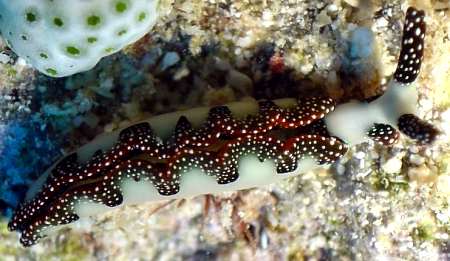
Thuridilla moebii
(Bergh, 1888)
Order: SACOGLOSSA
Superfamily: ELYSIOIDEA
Family: Elysiidae
DISTRIBUTION
Indian Ocean. Mauritius, Reunion Is, Comoro Ids, South Africa, Houtman Abrolhos Ids [Western Australia].
PHOTO
Mayotte Island, Indian Ocean. Site : Passe en S, buoy n° 8. Depth: 12m. Length: 17mm. November 14, 2003. Photo: Marina Poddubetskaia
The body is translucent white, often with a tinge of bluish green. The intensity of the bluish-green may depend on the concentration of algal material in the digestive gland ducts, but too few animals have been reported to be sure. There is a broad dark brown band, scattered with numerous opaque white spots, along the wavy edge of the parapodia. The rhinophores are also brown with white spots and there is a similar coloured patch on each side of the head. Gosliner (1995) describes the colour of the parapodial margin as consisting of an outer orange and an inner black band but from Marina Poddubetskaia's photos in the Forum it appears there is a single dark brown band which looks more orange towards the edge and darker [almost black] on the inside border with the greenish white background colour.
This species is known from only 4 previous records.
Note added 29 April 2010: Photos from the Andaman Sea suggest T. moebii may be a spotted colour form of T. coerulea. See message #23580.
- Gosliner, T.M. (1995) The genus Thuridilla (Opisthobranchia: Elysiidae) from the tropical Indo-Pacific, with a revision of their phylogeny and systematics of the Elysiidae. Proceedings of the California Academy of Sciences, 49(1): 1-54.
Rudman, W.B., 2003 (November 23) Thuridilla moebii (Bergh, 1888). [In] Sea Slug Forum. Australian Museum, Sydney. Available from http://www.seaslugforum.net/find/thurmoeb
Related messages
Thuridilla moebii from Andaman and Nicobar Islands
March 23, 2010
From: Sreeraj C R
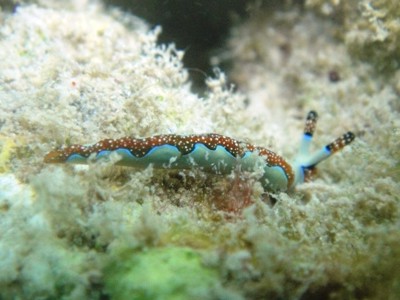
Dear Bill,
During the last week survey we have found some species of Thuridilla. Here I am sending the photograph of Thuridilla undula.
Locality: Nancowry Island, 8 m, Andaman and Nicobar, India, Andaman Sea, 28-02-2010, Coral reef area. Length: 5 cm. Photographer: Titus Immanuel.
We have got few animals which more or less matches with Elysia caerulea Eliot 1906. Those photos also i will send soon.
Regards
CR
crsreeraj@gmail.com
Sreeraj, C.R., 2010 (Mar 23) Thuridilla moebii from Andaman and Nicobar Islands. [Message in] Sea Slug Forum. Australian Museum, Sydney. Available from http://www.seaslugforum.net/find/23355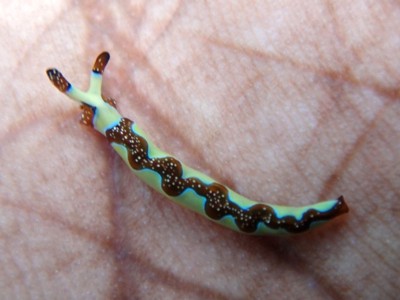
Dear CR,
This is an interesting find. Although it has considerable similarities to T. undula, I would say that the white spots on the brownish parapodial border and rhinophores would make this Thuridilla moebii, which is a species that has rarely been recorded since its original description.
Best wishes,
Bill Rudman
Thuridilla from Ningaloo Reef, Western Australia
January 18, 2006
From: Adrian Baddeley
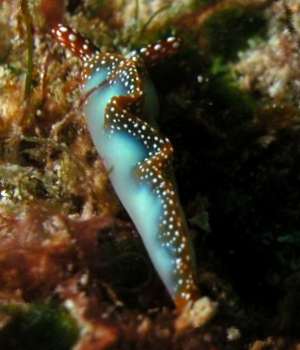
This looks like Thuridilla indopacifica although the colour pattern seems closer to T. moebii.
Locality: Mandu Mandu Wall, Ningaloo Reef, Western Australia. Indian Ocean. Depth: 10 metres. Length: 10 mm. 16 April 2004. Coral reef wall
Photographer: Adrian Baddeley
Individuals seen on two consecutive dives at Ningaloo Reef in April 2004. Found at 10 metres depth on gentle slope at base of a coral wall, 100 metres from shore, on ocean side of wall.
Adrian Baddeley
adrian@maths.uwa.edu.au
Baddeley, A., 2006 (Jan 18) Thuridilla from Ningaloo Reef, Western Australia. [Message in] Sea Slug Forum. Australian Museum, Sydney. Available from http://www.seaslugforum.net/find/15587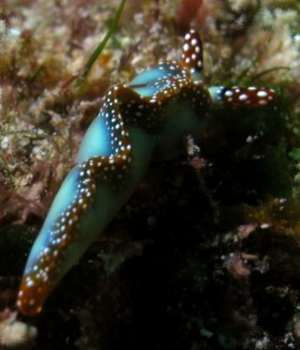
Dear Adrian,
This is T. moebii. I think we still have quite a lot to learn about colour variation in this group. Some apparently change colour depending on their physiological state, which is one form of colour variation, and then there is the genetic variability we find within a species. The limits to both these forms of variation do not seem to be clear as yet in many species. At present we can say the white spotted region on the parapodial edge and on the tips of the rhinophores are good characters of T. moebii. Also the way the background colour of the parapodial edge changes from orange to a dark blackish brown is not found in other species.
Best wishes,
Bill Rudman
Thuridilla moebii from Reunion Island
February 16, 2005
From: Philibert Bidgrain
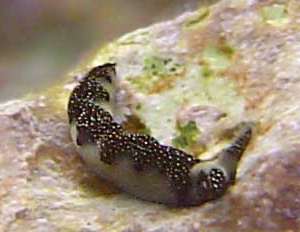
Dear Bill,
Reunion Island sea slugs:
We have found three specimens of Thuridilla moebii. This one was found by Emmanuel Eby at Saint Leu, Reunion Island. size: 10 mm. Photographer: Emmanuel Eby
Philibert Bidgrain
http://vieoceane.free.fr/runseaslug/indexslug.htm
pbidgrain@yahoo.fr
Bidgrain, P., 2005 (Feb 16) Thuridilla moebii from Reunion Island. [Message in] Sea Slug Forum. Australian Museum, Sydney. Available from http://www.seaslugforum.net/find/13099Thanks Philibert,
Best wishes,
Bill Rudman
Thuridilla moebii from Mayotte
November 24, 2003
From: Marina Poddubetskaia

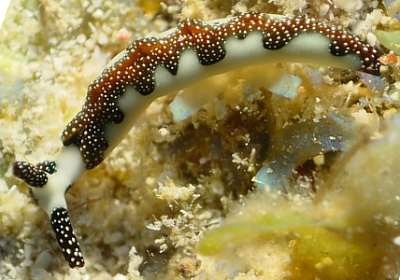
Dear Bill,
Here is a beauty from Mayotte (the Comoro Islands). Shireen Fahey has identified it for me as Thuridilla moebii (Bergh, 1888). I didn't know this species and it isn't on the Forum yet, so I hope you could give me some more information about this pretty guy. I found it under a dead coral.
Date: November 14, 2003
Location: Mayotte Island, Comoro Ids, Indian Ocean
Site: Passe en S, buoy n° 8
Depth: 12m
Size: 17mm
Cordially,
Marina.
nembro@nembro.info
Poddubetskaia, M., 2003 (Nov 24) Thuridilla moebii from Mayotte. [Message in] Sea Slug Forum. Australian Museum, Sydney. Available from http://www.seaslugforum.net/find/11481Thanks Marina,
This is an excellent find, as this is only the fifth time this rare elysiid has been reported. Basically I can't tell you much about it, other than what I have added to it Fact Sheet.
Best wishes
Bill Rudman
